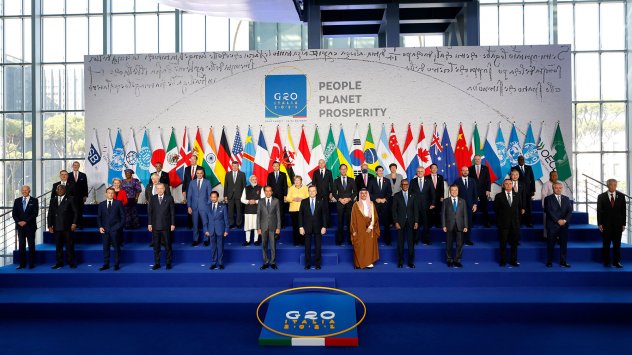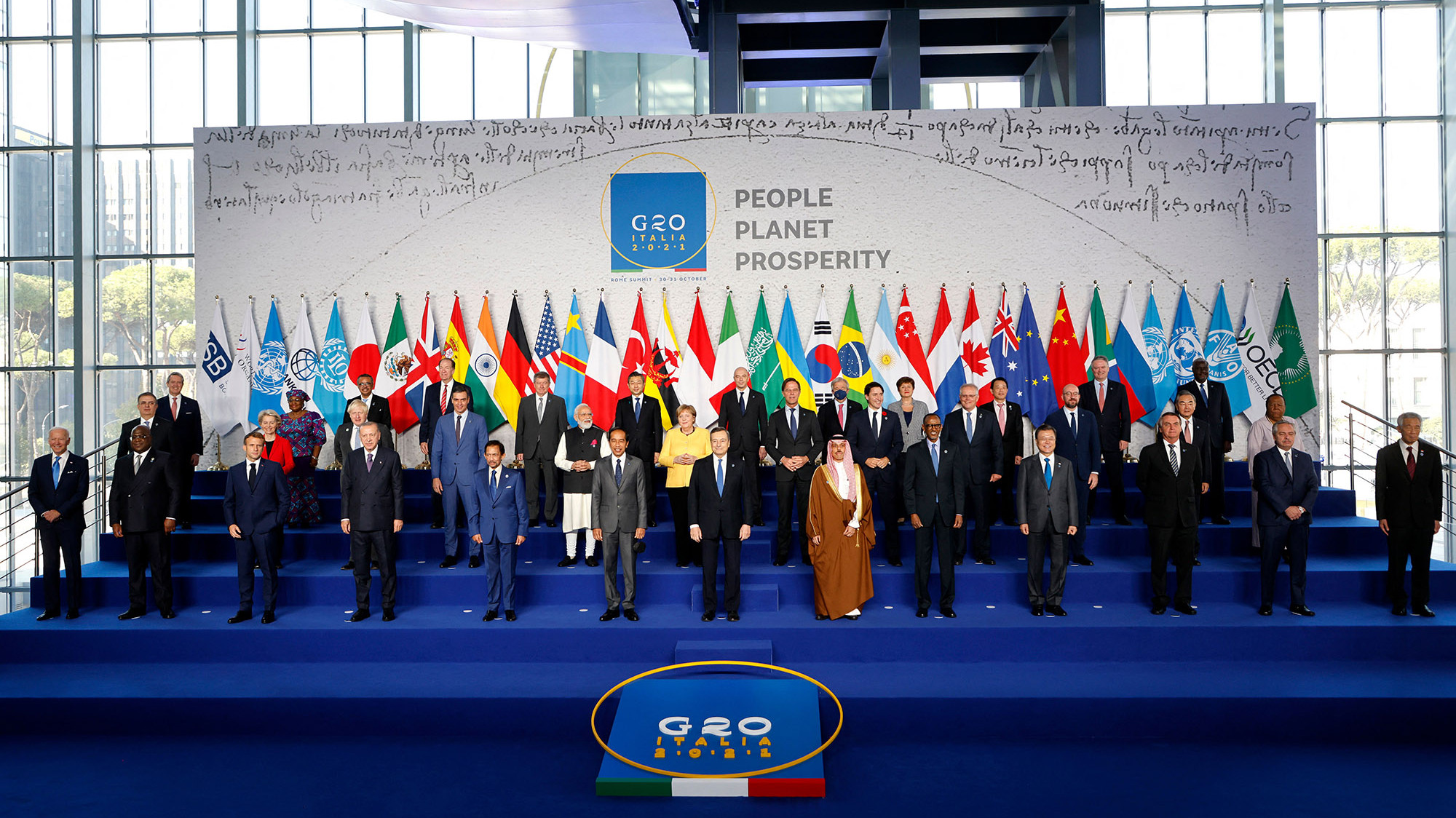
If climate changes were a soccer match, mankind would be trailing 1:5 - at half-time. This is how Britain's Prime Minister Boris Johnson described the situation at the World Climate Conference in Glasgow in his usual jovial manner - and perhaps not entirely appropriate to the seriousness of the situation. At least not if you believe the doom and gloom apologists who give little time to a successful fight against global warming.
After the 14 days of negotiations, pledges and promises the interim result achieved was only 3:5. Goals failed, yet the hope still remains. Well, at least for now.
Instead of soccer, the final game for the climate actually has more to do with poker. 130 heads of state were gambling for concrete commitments supposed to guarantee that the goals of the Paris climate protection agreement will be met.
A radical reduction in methane emissions, an imminent halt to global deforestation, the worldwide linking of green electricity grids - these initiatives are being hailed as successes. But is it enough? According to a study by the Global Carbon Project, global CO2 emissions in 2021 will be back to pre-pandemic levels.
In Rome and Glasgow between 30 October and 12 November, world leaders pledged to curb methane emissions and halt forest destruction on the margins of the G20 summit and the UN Climate Change Conference, known as COP26. The meeting in the Scottish capital was billed as humanity's "last chance" to solve the planet's climate problems.
Really, in terms of the number of participants, the Glasgow Climate Summit was is setting new standards with 130 heads of 200 states and nearly 40,000 registered delegates, including business leaders such as Amazon CEO Jeff Bezos, that filled the list of participants of more than 1,600 pages thick. This made the climate conference by far the largest to date. And yet, critics have long considered the cumbersome negotiation format within the framework of the United Nations to be highly inefficient in bringing about the urgently needed joint global action on climate protection. More that that: 400 private jets took off and landed during the summit, emitting 13,000 tons of CO2. That's more than 1600 Scots could burn in a year, the Sunday Mail outraged. It was not a shining example. And it outlined the often long way from promises to actual action. And we are moving in completely the wrong direction.
Back in 1992, more than 150 countries agreed in Rio de Janeiro to stabilize greenhouse gas emissions at a level that would "prevent dangerous interference with the climate system." By 2021, emissions are projected to rise by the second largest amount ever. Countries are light years away from the Paris climate targets to stop the planet from warming more than 1.5 degrees Celsius above preindustrial levels. In reality, with the measures taken or planned to date, the global temperature will rise by 2.7 degrees Celsius by the year 2100. Stopping this would require the world to halve greenhouse gas emissions by 2030 and reach net-zero emissions by 2050, something no major economy is on track to achieve.
The UN Secretary-General Antonio Guterres harangued the gathered leaders to act to save humanity. "It's time to say: enough. Enough of brutalising biodiversity. Enough of killing ourselves with carbon. Enough of burning and drilling and mining our way deeper. We are digging our own graves," he said in light of the latest report from the Intergovernmental Panel on Climate Change. "We are on the brink of the abyss".
U.S. climate envoy John Kerry also warned of the dramatic impacts that exceeding the 2015 Paris accord’s goal will have on nature and people, but expressed optimism that the world is heading in the right direction.
Vowing that the U.S. will “lead by the power of our example,” President Biden joined the leaders of more than 100 nations in signing a pledge to reduce emissions of methane—a potent greenhouse gas released by oil and gas operations, livestock, and landfills—by 30% by 2030. Major methane polluters, including China, Russia, Australia, and India, did not sign the deal. A pledge to end deforestation by 2030 was agreed to by more than 100 countries. Biden called out Chinese President Xi Jinping and Russian President Vladimir Putin for failing to attend the summit. Climate change is “just a gigantic issue,” he said, “and they’ve walked away.”
China and Russia are the world’s highest and fourth highest greenhouse gas emitters respectively, with China alone emitting a jaw-dropping 27% of total global emissions. China is something of an oddity. Despite being the world’s largest producer of renewable energy technology and products, almost 60 % of its energy is produced by coal. Even more distressingly, from a climate change perspective, the country has financed 240 coal-powered plants in Africa and Asia as part of its Belt and Road Initiative, and it’s feared that those plants will produce almost 50% of the world’s carbon emissions by 2050.
China’s and Russia’s absence from COP26 was indeed reproachful, but other leaders were in no position to point fingers. The plans being discussed in Glasgow were and actually “an elite farce of a traveling circus”, pointed out New York Post and . It’s easy for world leaders to talk about grand and costly schemes to save the planet, it’s another “to ask voters to pay for these draconian climate policies.” To cut emissions without sparking an uprising, we should pump investment into fusion and fission technology, solar and wind power, and “second- generation biofuels.” As soon as we “innovate the price of green energy below fossil fuels,” real change will follow.
Luckily, this time in Glasgow there were practical alternatives to the traveling circus of green mega-conferences. For a long time, it was only discussed as a theoretical thought game by experts and now the time has come for it to be fullfilled.
This time one area where enthusiasm was growing was the climate finance, as the financial industry annouced its plans to save the world. The most striking announcement in Glasgow has come from financial institutions, representing nearly $9 trn in assets as thez pledged to uproot deforestation from their investment portfolios. One of them, the Glasgow Financial Alliance for Net Zero (GFNZ), whose members include asset owners, asset managers, banks and insurers, hold about $130 trn of assets. They will try to cut the emissions from their lending and investing to net zero by 2050.
This ia s goal that requires a vast reallocation of capital with the aim to shift the economy from fossil fuels to clean sources of energy. It was estimated that at least $4 trn of investment in clean energy will be needed each year till 2030, three times more than the current levels. In an ideal world the profit incentive of institutional investors would be aligned with reducing emissions, and these owners and financiers would control the global assets that create emissions. Asset owners would have both the motive and the means to reinvent the economy.
The Green G-7
But we should not ignore the political aspect of global climate change. In this aspect, weapons of mass destruction are perhaps the most serious challenge to green peace.
Weapons of mass destruction are perhaps the most serious challenge to green peace. It is good to point out that we are talking about nuclear weapons, after all, because the proliferation and testing of chemical and biological weapons reminds of a Hollywood action. Paradoxically, nuclear bombs can destroy humanity in one day, while nuclear tests are likely to do so more slowly. But it is more certain. Many still believe in the mutual promises made by US President Jimmy Carter and Soviet leader Leonid Brezhnev when they declared the seas and oceans an inviolable and universal heritage. However, those times are long gone and even if someone in Washington and Moscow remembers these meetings, it will be either with undisguised nostalgia or with obvious hostility.
Evidence of this is that shortly before the Covid-19 pandemics, the States and Russia unilaterally withdrew from several key agreements that, if not eliminated so far, at least reduced the possibility of nuclear attempts to scale up. China, on the other hand, is not a member of any global WMD disarmament or limitation agreement. Japan, a global economic power, was disappointed by the US refusal to include it in AUKUS and continued to pour radioactive water from Fukushima into the Sea of Japan. And Europe is so preoccupied with the pandemic that green security is unlikely to be a priority for Germany's future chancellor or for French President Emmanuel Macron, who is facing elections. Under these conditions, we can assume that nuclear testing will continue, which will inevitably lead to shelf contamination as well as the dispersal of radioactive waste in the oceans and deserts.
A serious problem which once made George W. Bush to withdraw from the Kyoto Agreement was the harmful effects of gas emissions. Statistics show that if the United States and China continue to ignore the UN warning, the armed race between them might have its consequences for the whole world. At the beginning of the pandemic after the forced emergency measures of governments. the levels of harmful gas emissions fell by one third. However, once the WHO approved the vaccines, the process was reversed. Vaccinating their populations, state leaders went back to investing in brute force, forgetting the lesson Coronavirus had taught them.
Washington's new project, which involves the design of an improved generation of "multi-terrain" tanks, requires the printing of about a billion dollars, which will be injected into the military industry. Beijing continues to build its navy, with Chinese military strategists focusing on improving the capacity of new hypersonic missiles - so far the only element in China's arsenal that can effectively hold Washington back. And when we are talking about harmful emissions, let's not forget the fuels that cause great damage to green spaces, very figuratively called by human rights activists "the lungs of the earth." This is hardly a problem for Russia's vast taiga, but Germany and France, which are planning to set up a rapid reaction force, need to think about it.
Global warming and ozone depletion are another segment of the issues that the G20 will have to deal with in the next ten years. There are two opinions about how much it is worth losing our sleep, due to the sharp rise in temperatures and lack of seasons. The first is that global warming is a natural process that cannot be stopped, and humanity has to make the most of the opportunities that new technologies offer. The second point is that we can stop the diminishing of the ozone layer with a little more will and restraint. However, experts on both sides acknowledge that the damage is irreversible and that the holes in the layer are visible from space. Which logically portends a global catastrophe. Against the background of US and Chinese military maneuvers in the Pacific, these warnings remained unheard for decades.
And finally, let us not forget one problem that the countries we somehow undeservedly call the "Third World" face on a daily basis - hunger. Shortly after the start of the pandemic, a cynical analysis emerged that the Coronavirus would naturally fulfill the task that the Black Plague used to face in the Middle Ages - to reduce the world's population to "acceptable limits." Other analysts believed that the coronavirus was preferable to war. The problem is that humanity has no choice and is actually facing both threats.
The pandemic did not play a constructive role, but rather catalyzed and antagonized US-China relations. If we look at the relationship between the world's population and the number of deaths, we will find that any theories for regulation of natural growth are groundless as a parallel to the Black Death, which took the lives of 60% of the inhabitants of the Old Continent.
The issue that will outlive the pandemic is certainly whether the middle class will survive. Because the crisis with hunger and overpopulation is not the result of a conspiratorial strategy but of the fact that the gap between the very rich and the very poor is deepening. If the middle class in developed countries disappears, then there is a real danger that the political elite in these countries will forget the meaning of the word 'humanitarian aid'.
A pragmatic look at the results of the Rome and Glasgow summits will highlight one indisputable fact: The G20 and COP 26 were a rare opportunity that gives the international community three unique chances. The first concerns world peace. If the US, Europe, Russia, China and the larger regional actors can coalesce around a 'green consensus', it will sharply reduce tensions in the world's hotspots. Second, if the Great Powers can find common ground on the hottest issues of the day, they may be able to restore some of the people's confidence in the political will of the leading states. And third, if the G20 decides to meet more often and recall the lessons of the Cold War, then perhaps the emerging bipolar world will seem to people even more attractive than the unipolar one.
The key question, however, is: will the Great Powers give Earth this unique chance?



